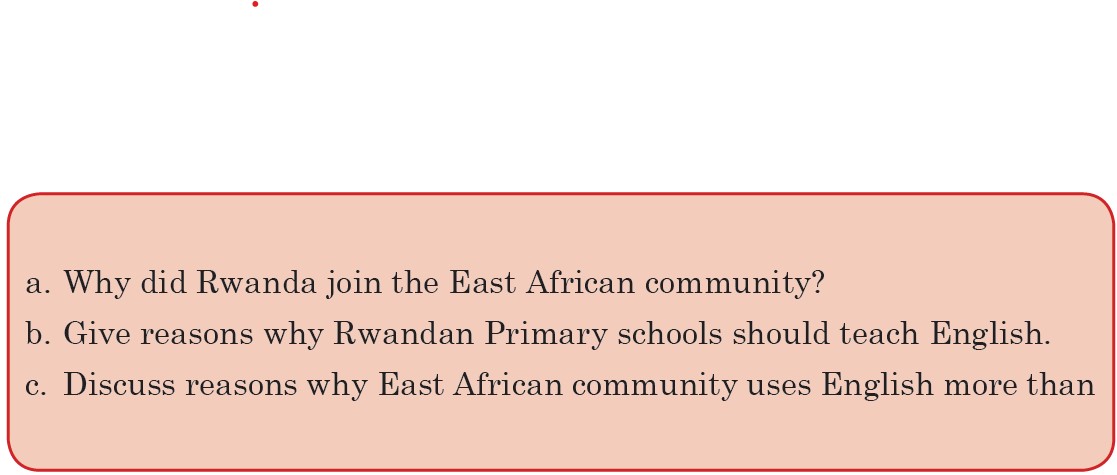UNIT 1: INTRODUCTION TO PRIMARY ENGLISH LANGUAGE SYLLABUS
Key unit competence: To justify the relevance of teaching English in primary schools and application of English communication skills in Rwandans’ daily life.
INTRODUCTORY ACTIVITY
Picture observation and interpretation

Observe the above figure and answer the following questions:
a. Discuss what countries located in East Africa have in common.
b. What does the emblem on figure 2 represent?
c. Discuss the two pictures above and in a composition of 200 words, relate your discussion to the relevance of teaching English in primary schools.
1.1. English teaching and learning rational in primary schools, Rwanda’s membership to EAC
1.1.a. Learning activity Read the text below and referring to your previous knowledge about EAC activities, answer the questions that follow:
English and Rwanda’s membership in East African Community The East African Community (EAC) was originally founded in 1967, dissolved in 1977, and revived with the Treaty for the Establishment of the East African Community (the Treaty Establishing EAC) signed in 1999 by Kenya, Uganda and United Republic of Tanzania. Burundi and Rwanda became members in 2007 while South Sudan gained accession in April 2016. Underpinned by their historical links, Kenya, Uganda and the United Republic of Tanzania had established strong economic cooperation laying the groundwork for further political, economic and social integration of the EAC member states.
East African Community is a regional, intergovernmental organization that coordinates some of the economic affairs and trade activities of its member states including Burundi, Kenya, Rwanda, Tanzania, South Soudan and Uganda. It also seeks to promote cooperation and integration among its member nations in a wide variety of policy areas, namely, science and technology, environmental and natural resources management, tourism and wildlife management, and health, social, and cultural activities. Rwanda joined the East African Community in 2007 and became part of the customs union. Economic observers have noted that the customs union has had a significant effect since it has allowed the member nations toenjoy increased revenues. The EAC Treaty adopted English and Kiswahili as official languages. But in this Community, the majority of the Rwandan population is still struggling to use English in business and meetings as well as several other areas of their daily life. This inadequate use of English has resulted into difficulties in common understanding and in-depth negotiations during EAC council and sector meetings, also for the follow up on agreed decisions or coordination of Rwanda’s EAC policy implementation
Comprehension questions:
a. When was EAC originally founded?
b. How many countries form EAC?
c. Which official languages does the EAC use for smooth running of business and policy implementation?
Notes:
Rwanda is part of East African Community and Commonwealth. The Rwanda Government has adopted English as one of Rwanda’s official languages to help its citizens integrate easily into these communities and participate in the global economic development. The use of English in Rwanda serves different purposes, the most important being the following:
- It is the medium of instruction in primary schools, starting at P4 grade and all through the other education levels.
- It is an integrating factor for the present Rwandan society made up of people coming from a wide range of cultural and linguistic backgrounds;
- It is a means of communication with the national and international community on politics, diplomacy, business, science, and technology;
- It contributes to the better understanding of other people and their diverse cultures.
The relevance of teaching English from pre-primary upwards Language is the vehicle through which knowledge is transmitted and therefore, it ultimately bound up with the process of education at all levels. English language is an essential tool in accessing content and skills in other subjects whose materials are written in English. Language for learning is found in most L2 situations. Here, the learner already has a L1 which is for everyday use. In most cases, the L2 is learnt in formal situations normally within a curriculum (English/French Teaching methods, EDC 203(2014). The teacher of languages should be aware that the second language acquisition should start at early age for better learning and that early grade pupils need to be exposed to contextual activities that stimulate their language learning.As indeed, before engaging English as both an official language and the language of instruction in Rwandan schools, Rwandans could not effectively relate with, transact and fully exploit business and other opportunities in East Africa, the Commonwealth, and the rest of the English-speaking world. However, with the introduction of English in Rwanda, these problems will be solved.
Therefore, Teaching English should start earlier enough that is from pre-primary upwards.



1.2. The structure of English Syllabus for Primary Schools in Rwanda.
1.2.a. Learning activitiesAnalysing a sample English syllabus unit




Study the table below from the English syllabus unit and answer the questions that follow.
a. What is a syllabus?
b. What are the components of the syllabus units?
c. Discuss the relationship between the syllabus and the curriculum
b) Look at the puzzle below and answer the question that follows:

c) Make sentences using words related to the roles of the syllabus.
Notes

1.2.1. Definition of a syllabus
A syllabus is a document which describes the learning objectives, content and learning activities of a specific subject.
1.2.2. Components of the syllabus verse the unit

1.2.3. Importance of the Syllabus
- To guide teachers on what content to teach
- To guide teachers on what approaches to use
- To guide teachers on how assessment will be done
- To guide teachers on resources to be used
- To Guide teachers on sequence of content and objectives for the year/Level
1.2.4. Relationship between the syllabus and curriculum



1.3. End unit assessment and remediation activities

